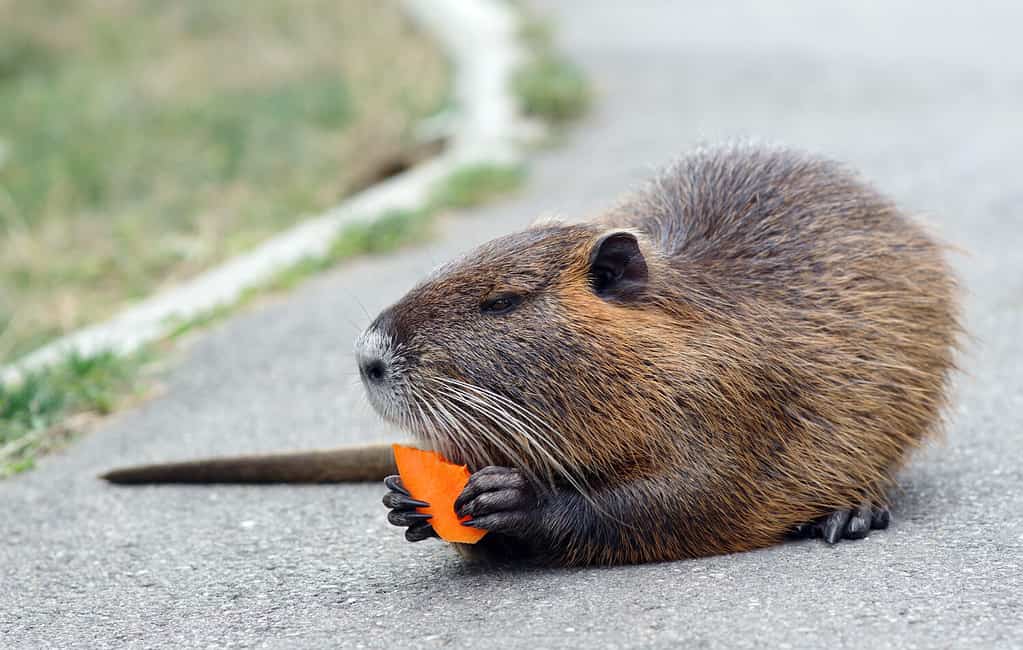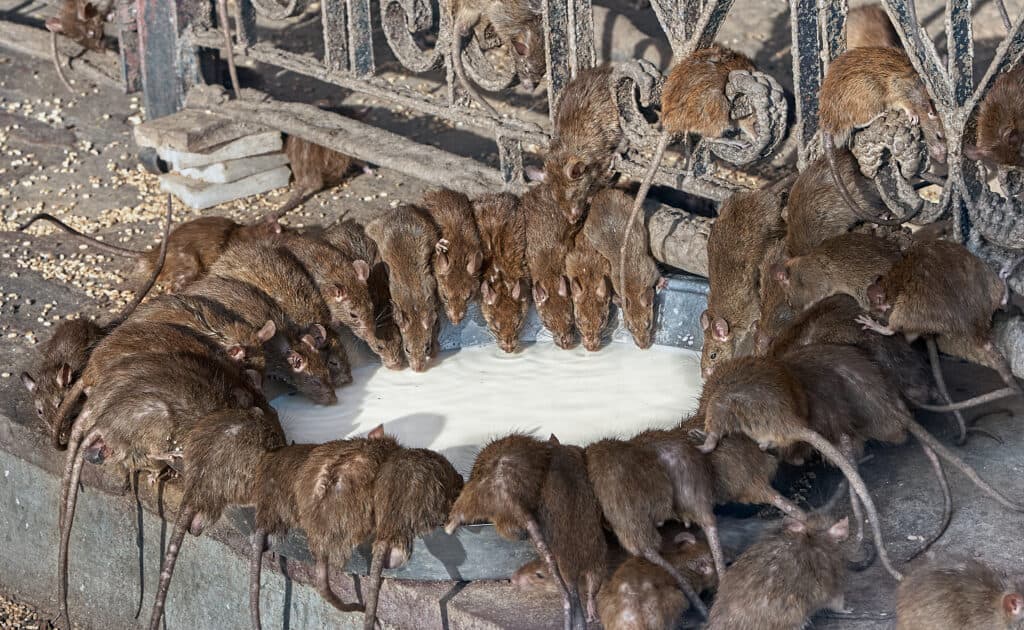Stories of giant rats have been coming out of England since 2020. The pandemic supposedly allowed rats to take over the cities and become massive and larger than cats. In 2023, these rats are again being discussed with vigor. There have been many questions about these so-called giant rats and if the photos people are taking are done in a way to make the rat appear much larger than they really are. Some say the rats they are seeing are four feet long, and many people are saying it’s not a rat at all in some of the photos.
In this article, we will take a look at what the common rats are in England and if any could ever grow to be cat-sized. We’ll also take a moment to investigate some of the places these giant rats are said to be swarming and why.
Types of “Giant” Rats in England
Unlike America, England is not home to many types of rats. Some of the neighboring counties have larger rodents, and some have large rats. None have giant rats the size of some of the claims out of England. The only rats types in England are the brown and black rats.
Brown Rat (Rattus norvegicus)

Brown rats are the most common type of rats in the world.
©Gallinago_media/Shutterstock.com
Appearance and Size
The brown rat is greyish-brown in color with almost hairless ears and a scaly-looking tail. They have round black eyes for seeing in the dark, like all nocturnal rodents.
The brown rat is 5.9 – 11 inches long with a tail that’s 4 – 9.5 inches long. They typically weigh 200 – 300 grams. The rat lives for up to three years.
Where You Might Encounter Brown Rats
Brown rats are in every city all over the world. In England, brown rats are the most common rats and are generally the type to get into trash, homes, and places where people and food inhabit.
Originally these rats came to Europe by ship from Asia.
Behavior and Diet
Brown rats are opportunistic foragers and scavengers. Being omnivores, they will eat almost anything. They typically are found where human food waste has accumulated. They are also known to get into animal feed. If human-supplied food is not available, they will eat grains, insects, eggs, fruit, and vegetables.
The brown rat is a social rat, and they are found in colonies that can reach hundreds due to their rapid rate of breeding. A female rat can have five litters of up to 12 babies per litter for the length of her life. So, one rat can produce 180 offspring in her lifetime. They are able to become pregnant when they are only three months old. These rats are able to dig their own burrows, though they commonly live in towns and cities among human-made structures.
Black Rat (Rattus rattus)

Black rats are not as common as they once were in England due to the Black Plague.
©Carlos Aranguiz/Shutterstock.com
Appearance and Size
The black rat is dark greyish-brown to solid black in color with pale grey, brown, or white on their underside. They have mostly hairless ears, pink or white feet, and a dark grey uniformly colored tail with short bristles of the same color. The eyes and ears of the black rat are much larger than the brown rat’s.
The black rat is somewhat smaller than the brown rat but can grow to be 4.7 – 5.5 inches long with a long tail that’s 5.5 – 10 inches long. These rats weigh approximately 100 – 280 grams. They live 18 months on average.
Where You Might Encounter Black Rats
The black rat isn’t as common around town streets, homes, or the outdoors as the brown rat in England. They are sometimes referred to as the ship rat because of their fondness for large dockside buildings and warehouses. They will nest in rocky cliffs near beaches or water if large buildings aren’t available.
Originally these rats came from India on ships and were said to be the cause of the Black Plague in Europe in the 15th century. It has since been disproven. The bacteria came from fleas, and the fleas lived on gerbils.
Behavior and Diet
The black rat is omnivorous but prefers grains, fruit, and vegetables over most other options. They are known to get into different types of agricultural grain.
A female black rat can produce, on average, seven babies in each litter. The amount in each litter heavily depends on the size of the rat. Between the months of March – November, up to five litters are had on average. In its lifetime, a black rat can produce 70 offspring, which is not even half the number that a brown rat can produce.
Coypu (Myocastor coypus) – Not a Rat

Coypu or nutria have been eradicated from the UK, though one was caught long after the fact in 2012.
©KRIACHKO OLEKSII/Shutterstock.com
Appearance and Size
The coypu, sometimes known as a river rat or nutria, are commonly found near bodies of water. The semi-aquatic rodent is brown with a long hairless tail, similar to what giant rats are said to look like. They have large orange teeth, a white patch on their muzzle, and webbed hind feet. The three-inch long guard hairs are coarse and dark brown. Under that is a brownish coat with soft grey fluff underneath that layer of fur.
The coypu weighs 9 – 20 pounds and are 16 -24 inches long with a tail that is an additional 12 – 18 inches long. They can weigh up to 35 pounds but generally average 15 pounds. They live up to 12 years in captivity but the average in the wild is 6.5 years.
Where You Might Encounter Coypu
The coypu is semi-aquatic and lives near bodies of water. They prefer brackish and freshwater marshes and swamps. The coypu is native to South America and were brought to Louisiana for the fur trade. A hurricane swept through, and people evacuated, leaving the caged coypu behind. They were able to break free when the hurricane destroyed the cages and have since been an invasive species to the Louisiana wetlands. During the 1930s, coypu were first introduced to England from the German fur trade. Subsequently, the nutria were able to escape their cages and quickly multiplied in the wild. They are still seen occasionally in southern England and East Anglia.
Behavior and Diet
The large rat-like nutria are herbivores and prefer to dine on roots, shoots from marsh plants, grass near the water, tubers of cattails, cordgrass, and shrubs. They will occasionally eat a snail or shellfish. They are known to eat 25% of their body weight in plants daily.
Where The Giant Rats Have Been Spotted

Castle Beach in Wales, England, is one area locals say is being destroyed by large rats.
©Richard Whitcombe/Shutterstock.com
Below is a list of giant rat sightings in England. Some of these sightings may have been nutria/coypu and not a rat at all. Also, the length of these so-called giant rats is in line with the larger end of the brown rat’s scale. They are not giant rats but rats that are well-fed and reach their full size potential.
Castle Beach, Wales
The seaside community in Wales, Castle Beach Tenby is near Tenby in Pembrokeshire, had issues with giant rats apparently burrowing underneath the front of the cliff face. Beachgoers were concerned that the cliff would destabilize and fall. The town’s mayor informed the public that the situation was being taken care of this past March.
This is, once again, humans’ fault for feeding birds so much food that it attracts rats and even more so for tossing their food trash wherever they feel like it. So much trash has accumulated that the rats have been eating very well for a long time. This is the sad result of most beach communities once tourist season wraps up.
Norwich, England
In Norwich, a woman reportedly found a rat in the toilet. She was sitting on the toilet and heard a small sound, and when she looked, there was a large rat in the toilet. This, of course, led to people believing that rats were coming up through the sewers, which is extremely unlikely. The town was overrun with trash piling up, and rats were attracted to the area because of the ease of acquiring food.
Lambeth, South London, England
In 2018, a south London home was plagued by giant rats supposedly the size of dogs. One rat measured 20 inches long, which from tail tip to nose, is not unheard of for a brown rat. The homeowner reportedly moved out of their home following the invasion.
Birmingham, England
The giant rats reached two feet long in Birmingham and Liverpool. It was reported that the rats had become the size of small cats. Again, this is not uncommon for a healthy, well-fed brown rat.
Cornwall, South West England
A family in Cornwall who was storing their dog’s food outside in a shed discovered a giant rat that measured 19 inches long from nose to tip of the tail was eating the dog food. Improperly storing animal feed is a surefire way to attract nuisance animals and insects.
New Alresford, Hampshire, England
In 2017, a 20-inch long giant rat was caught in a suburban home’s garden in New Alresford. This shows that the giant rat problem did not, in fact, begin with the pandemic’s closing of businesses and streets. The brown rat has been in England for many centuries. With the abundance of food trash available, why would an opportunistic scavenger like the rat pass up an easy meal? These rats moved in, and since they are able to reproduce quickly and grow the colonies to large numbers, not enough places are available for the rats to live near the free food, in which case, they move into a human’s dry, comfortable home or garage. Wouldn’t you do the same if you were a small creature just trying to survive?
Bournemouth, Dorset, England
In 2018, a 21-inch long giant rat was found behind a garbage bin in Bournemouth.
A Rat’s Tale

Rats are opportunistic scavengers and will gladly help themselves to any food left out or thrown in the trash.
©iStock.com/kulbabka
It is quite possible that some of the giant rat sightings were of nutria. It is most likely the case of the brown rat becoming large and severely overpopulated due to the abundance of food in these towns. The people living there, or anywhere, need to acknowledge that these monster rats are not out to get them and are simply doing what their instincts guide them to.
Once the rats discovered the massive quantities of trash piling up in England, they moved in and raised families. The food continued to pour in without any real predators hunting the rats, so the rats continued to multiply. Once the rats’ numbers reached epic proportions, they ran out of space to live. Many rat colonies have one “alpha” male and many females with offspring. If a male rat is born into the colony, he could be kicked out once he is old enough, which would send him scurrying to find a new home. The lesson of this article is to not be wasteful and not to feed wildlife.
The photo featured at the top of this post is © iStock.com/Nigel Harris
Thank you for reading! Have some feedback for us? Contact the AZ Animals editorial team.







